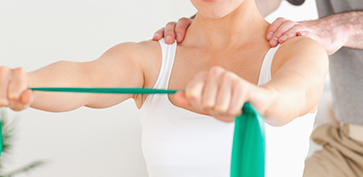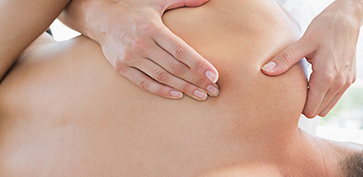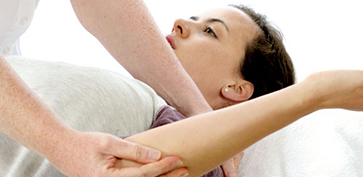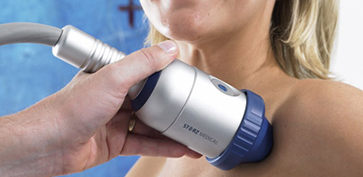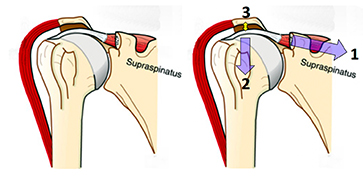Physiotherapy
Physiotherapy
The management of any shoulder & elbow condition, whether operative or non-operative, usually requires the input of Specialist Physiotherapists to obtain the best results. Shoulder Physiotherapy is becoming its own specialist area with different modalities of treatment and exercise programmes now being developed for multiple conditions. In addition, a particular condition may require differing types of physiotherapy at certain stages of its recovery or to its response to treatment.
Shoulder Physiotherapy
Shoulder Physiotherapy is aimed at regaining and maintaining movement of the shoulder girdle. It is also aimed at strengthening muscle groups and building stamina and endurance.
Normal movements and stability around the shoulder require a complex co-ordination of muscle groups working in a set sequence. These co-ordinated sequences are often significantly disturbed following a shoulder injury or problem. Shoulder Physiotherapy can assess these types of disturbances and work to regain normal stability and movement of the glenohumeral joint and the scapula.
Physiotherapy Rehabilitation Programmes
Different shoulder conditions and injuries can require very different rehabilitation programmes. In this Physiotherapy Section we have set out our standard rehabilitation programmes and exercises for the majority of the Shoulder problems and surgeries that I see and undertake.
Every patient’s response to injury and surgery and their recovery is slightly different. These programmes are a basic guide and framework. The specific exercises and timings to recovery for any individual will be set out and adjusted by the Physiotherapist undertaking their treatment.
If there are any significant concerns with regards to a patient’s recovery or progress the Physiotherapist will contact me to discuss this further.
Types of Shoulder Physiotherapy
Types of Shoulder Physiotherapy
Different types of Physiotherapy and rehabilitation regimes are usually required at different stages in recovery for any type of shoulder problem. Although there are general rehabilitation programmes and timings for most conditions these are, at best, a rough guide. For any individual, a Shoulder Physiotherapist can assess the exact extent or stage of recovery of their problem and tailor a specific programme around them. They will also assess the patients goals and demands which may range from normal day-to-day function or returning to elite level sports.
- Diagnosis – a Physiotherapist is often the first person that a patient might see with a shoulder problem. They assess the patient and advise and instigate treatment. In certain situations, where a condition does not respond or is of a certain type or severity, they will recommend referral onto a Shoulder Surgeon.
- Movement – a Physiotherapist assesses the range of shoulder movement and can instigate a rehabilitation programme. This may initially involve hands on manipulation but, as the range recovers, specific exercises using certain equipment such as pulleys and exercise balls.
- Strengthening – stretching and strengthening the various muscle groups around the shoulder goes hand in hand with regaining range of motion. Any period of injury or immobilisation will lead to some weakening and atrophy of healthy muscles as well as those that might have been injured. A rehabilitation programme will be aimed at strengthening set groups of muscle starting with simply being able to move the shoulder against gravity, working through increasing resistance with Therabands to full-blown strengthening. Recovery is aimed at regaining muscle strength leading to endurance and stamina.
- Co-Ordination – movement and stability of the shoulder relies on a complex arrangement of various muscle groups working in set sequences. Stabilising the scapula, to create a stable platform for the gleno-humeral (ball & socket) joint, to work and stabilising the gleno-humeral joint itself are essential to regain normal shoulder function. A physiotherapist is able to assess deficiency in any of these areas and to set in place specific rehabilitation programmes.
- Pain Relief – pain & inflammation are commonly associated with shoulder injuries and problems. Before any meaningful physiotherapy, in terms of movement and rehabilitation, can be undertaken any significant pain and inflammation needs to have settled. This usually has to be achieved by rest or anti-inflammatory medications. However there are some treatments, such as Ice/Cryotherapy, Heat and Therapeutic Ultrasound that the Physiotherapists can use to help with this.
- Monitoring Recovery – one of the most important jobs of a Physiotherapist is to assess and monitor a patient’s recovery and to tailor treatment in response to this. In general, the Physiotherapist is the person who spends the most time with a patient as they undergo their rehabilitation phase after surgery. They are able to advise the patient and feedback to the surgeon on how recovery is progressing.
Physiotherapy – Rotator Cuff
Physiotherapy: Rotator Cuff Surgery
Rotator Cuff Repair
- Rotator Cuff Tears usually occur in tendons that have undergone ‘wear and tear’ and, as the tear occurs, the degenerate tendon is no longer strong enough to withstand the mechanical forces placed on it
- When a Rotator Cuff Tendon is repaired, it is still degenerate and, as a result, its healing potential is not as good as a normal, healthy tendon
- Surgical techniques and implant technology are constantly advancing and we are currently able to mobilise and successfully repair nearly all tendon tears
- However, having repaired the tendon it still has to heal!
- It takes up to 6 months for the tendon to have healed biomechanically to its optimum strength
- For the tendon to heal as strongly as possible it needs to be stimulated by subjecting it to an increasing load
Find out more about Rotator Cuff Tears, Repairs & Healing ….
Aims of Treatment
- Allow Rotator Cuff Repair healing to establish whilst maintaining residual movements
- Regain a full passive range of movement whilst protecting the Rotator Cuff Repair
- Regain full muscle strength, range of motion and optimise healing
Physiotherapy Following a Rotator Cuff Repair
Successful Physiotherapy following a Rotator Cuff Repair involves 3 phases,
Phase 1: Sling Immobilisation with Passive Range of Motion Exercises
Phase 2: Active-Assisted Range of Motion Exercises
Phase 3: Active Muscle Strengthening
Phase 1: Sling Immobilisation with Passive Range of Motion Exercises
- This is the period immediately after the surgery where a sling is required
- The exact length of time for this can vary depending on individual surgical factors
- The sling does not need to be worn all of the time and the elbow and wrist can be moved freely
- There are certain ‘safe zones’ of shoulder movement that will not disturb the repair
- The repair can be moved by Passive movements only (the arm can be lifted up by the un-injured arm or by someone else, but the repaired tendon and its muscle group must NOT be activated)
Exercises ….
Phase 2: Active-Assisted Range of Motion Exercises
- Having allowed the tendon repair to initially begin to heal the next phase is to gradually regain range of movement whilst applying a controlled and increasing load at the repair site
- Active-Assisted exercises involve the shoulder initially being moved entirely by the Therapist or by using a pulley and then gradually decreasing this assistance whilst increasing muscle movement
Exercises ….
Phase 3: Active Muscle Strengthening
Exercises ….


